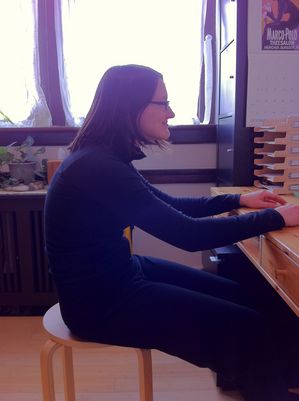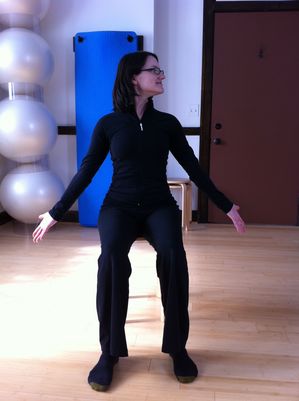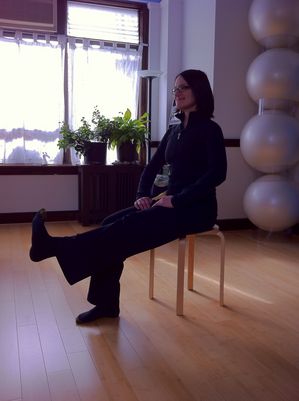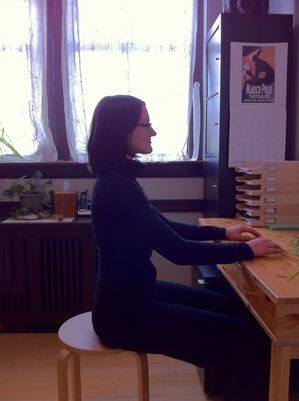Exercise at your desk to beat the computer blues

Allison Walacavage demonstrates poor computer posture.
Heather Glidden | Contributor

Allison demonstrates desk exercise #1.
Heather Glidden | Contributor

Allison demonstrates desk exercise #2.
Heather Glidden | Contributor

After her desk exercises, Allison is ready for the rest of her day!
Heather Glidden | Contributor
Fortunately, help is available! Massage can help to alleviate many of the strain patterns that develop from long periods spent sitting at a desk and frequent small movement breaks can also help to keep your body feeling good. Check out this excellent piece from the New York Times about why your chair is your enemy. This piece came out last February and it is still a favorite of mine for explaining to my clients why it is so important for them to incorporate movement into their daily lives. Getting your workout 2-3 times/week is great, but it will be so much more effective if you keep moving between workouts!
Now that you are inspired to move, here are two simple exercises you can do at your desk to get your blood moving a little bit and help improve your posture. Start out by planting your feet on the floor, move forward a bit so you are close to the edge of your seat (without being in any danger of falling off), and sit tall.
1. Chest opener Start by reaching your arms straight down by your sides. Keep your hands reaching for the floor as you turn your palms forward and then continue turning them as far as they will go. You may feel a stretch through your arms and possibly across your chest as well. Go to a place where the you feel the stretch but it isn’t so intense that you feel yourself tense up. Then keep the palms turned forward and slowly turn your head side to side to add a gentle stretch in your neck.
2. Leg Reaches Start by reaching one leg forward so the knee straightens (or gets as close as possible to straight). Make sure you keep sitting tall so you don’t slouch back in your chair as the leg reaches. Once the leg is straight, pull your toes back and reach through your heel. You should feel a stretch in the back of your leg. Optional: While the leg is lifted, you can turn toward it to add a little stretch for your back. Remember to repeat on the other side.
Heather Glidden owns Willow Wellness Studio in downtown Ann Arbor where she teaches Gyrotonic and Pilates and practices massage. She is passionate about helping people to learn more about their bodies. Got a body question? E-mail her at info@WillowWellnessStudio.com and she will do her best to answer it or find someone who can! Look for her posts on Friday mornings.


Comments
Heather Glidden
Thu, Nov 4, 2010 : 7:49 p.m.
Actually, I have observed that it is not so much about the chair itself as about how you sit in it. The wooden stool sits at the desk at my studio and it is true that we do not use it for long periods of time -- mostly we are just at the desk for quick notes or a snack between clients. However, the stool allows for a perfectly correct posture where I find that many chairs that claim to be ergonomically correct do not. On a related note, the speaker in your second video claims that a reclined posture is healthier for the spine. I would like to know what her evidence of that is. In your third video I note that the woman in the reclined chair has to hold her head up. Over time this will cause the neck flexors (muscles on the front of her neck) to shorten which is going to cause her postural problems when she stands up. Admittedly, as a movement teacher my bias will be towards using the function of the body to help to correct it structurally. That said, for my money, I think I would prefer Ed's treadmill desk to the reclining chair for promoting correct posture and an even balance of strength through the intrinsic muscles of the spine, pelvic floor and abdominal muscles (all of which help to hold you together and keep the structural integrity of your body).
rreidannarbor
Sat, Oct 30, 2010 : 1:45 p.m.
Working for Herman Miller locally, I talk about these issues almost daily. Changing seated postures, allowing work to occur from a seated to a standing posture and maintaining concordance with your technology. Allowing full, deep reclining while continuing to do one's work is not easy to do unless you have the correct tools to allow this. At least those tools are available now (I can only assume the wooden stool is a surrogate for a more ergonomic chair and no one would really use something like that for more prolonged work?). Here are some additional videos on this topic. I tell my customers if you can't acquire these tools, then by all means, at least get up and out of your chair on occassion and take a break and do some of the simple exercises suggested above, take a walk, stretch, etc. Ergonomics and Posture: http://www.hermanmiller.com/Videos/1015/0 Using technology in concordance with primary work tools, keyboard, laptop etc: http://www.hermanmiller.com/Videos/1018/0 One way this is done. Working in concordance with technology... http://www.hermanmiller.com/Videos/808/0 Repetitive motion injuries and back/neck strain can be dealt with. I'm glad to see advice being given on doing the exercises. Convicing all of us who are seduced by our technology to do these things is kind of like sticking to a diet however. It takes discipline.
Heather Glidden
Sat, Oct 30, 2010 : 10:55 a.m.
Sounds like a great idea!